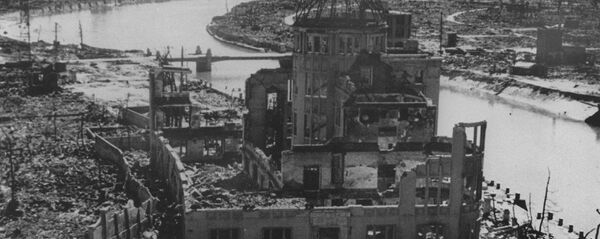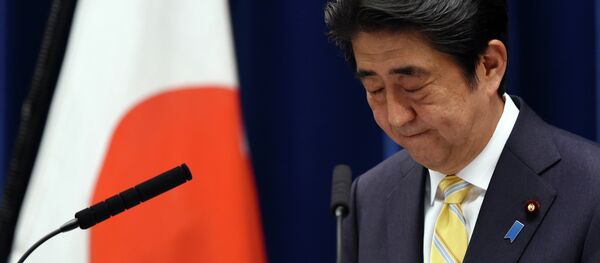HIROSHIMA/TOKYO (Sputnik) — In 2015, the average age for survivors exceeded 80 years for the first time. People of this generation are gradually passing away, and people are afraid that memories of the horrors experienced by these individuals will fade, and that humankind may repeat the same mistake.
THE HIBAKUSHA
"I was 20 years old when they dropped the nuclear bomb. I was standing 1,200 meters [0.75 miles] away from ground zero and near city hall. The Hiroshima Peace Memorial Park is located there now. I was a student at the time and was on my way to the university," Sunao Tsuboi, Chairman of the Hiroshima Prefectural Confederation of A-bomb Sufferers Organizations, reminisced.
Tsuboi said he bumped into his friends, who were going to the canteen to breakfast. He did not join them, telling them he would see them later.
Keiko Ogura, 78, another Hiroshima bombing survivor, was eight years old in 1945. She recalls the blast wave that knocked her on the ground, and she blacked out.
"It was dark when I regained consciousness. It seemed as though night had descended on the city. The city was crushed by the explosion. It seemed that some giant foot had stepped on the city and squashed it. Fires started breaking out amidst the ruins. To save ourselves from the flames, we had to run through streets filled with dead bodies," Ogura told RIA Novosti.
Ogura added that children were afraid to go out because passersby looked like nightmare ghosts.
"Their burned skin peeled off together with their flesh. They walked with their arms stretched out because it hurt when they tried to lower them, and the stench of burned hair was everywhere. The intestines of many people were sticking out. It appeared that people were holding something near their bellies, but that was their entrails," Ogura continued.
She quickly learned to tell the living from the dead. "I quickly realized that if a person stopped moving, despite all of the suffering, then he or she was dead, and I showed the dead bodies to adults who burned them. They burned the bodies where a monument to the deceased girl Sadako now stands," Ogura stated.
The Hiroshima Peace Memorial Park and Hiroshima Peace Memorial Museum are located at ground zero. The latter displays documents and exhibits related to the nuclear bombing. It also offers audio guides in the languages of all of the nuclear powers. So far, no incumbent leader of these countries has visited Hiroshima.
The iconic exhibits recreate the horror of the 1945 bombing: A mangled tricycle damaged by the explosion, its little owner probably blown to bits. Rice grains, roasted coal-black inside a metal lunchbox belonging to a school student.
"The real story behind the nuclear bombing is absolutely terrifying. Many exhibits are never displayed because the museum experts are afraid they may scare the children stiff. I’ll never forget what I saw while seeking medical treatment after the explosion," Sunao Tsuboi said, speaking of his experiences after the blast.
He tried unsuccessfully to call for help, so that someone could extract the people from the rubble. But everyone was running away from him because he looked like a ghost. His skin was flayed, his ears were torn off, and his face, arms and hands were covered in burns.
When he finally reached his grandmother’s home, she did not recognize him because his body was swollen and his face was disfigured.
MEMORY
For years after the war, many survivors tried to conceal their plight, even from their own children.
"We were subjected to brutal discrimination. Those with keloids could not visit public baths for fear of exposing themselves. Quite often, the parents of a young man rejected his fiancee because of her hibakusha status, and vice versa," Keiko Ogura said.
She started telling about her experience as a Hiroshima survivor after realizing that the memory of the nuclear bombing was dimming and the younger generation was gradually forgetting what happened to the city on August 6, 1945
Three years ago, city residents of all ages volunteered for a project involving the survivors who described what they had experienced. Volunteers chose one or several Hiroshima survivors, spoke with them for a long time and absorbed their experiences. The museum stores video and sound recordings of their narratives. Since then, about 50 volunteers started a speaking tour at the museum, city schools and other cities, recalling the older generation’s experiences.
MISSION
The people of Hiroshima see their mission in preserving the memory of the nuclear bombings of Hiroshima and Nagasaki and in preventing their repetition. This was stated as a prime objective by 80-year-old survivors of the nuclear holocaust and 15-year-old school students acting as ambassadors for peace who visit the UN Office at Geneva (UNOG) each year.
The students collect signatures in favor of abolishing nuclear weapons and submit the petitions to UNOG. Over one million signatures have been collected since 2001.
"Most importantly, we must prevent a repetition of these events. This is the mission of Hiroshima. We need to overcome political and national differences and disagreements and realize that this was a terrible experience not only for our city but for the entire human race. Hiroshima is making statements worldwide and trying to preserve memories of the nuclear bombing in line with these concepts," Hiroshima Mayor Kazumi Matsui, whose mother survived the nuclear bombing, told journalists in the run-up to the tragedy’s 70th anniversary.
He points out that nuclear weapons do not act as a deterrent because as long as they exist the possibility of their use remains.
DO NOT SEARCH FOR CULPRITS
The people of Hiroshima are frequently asked about whether they hate those who dropped the nuclear bomb on their city in August 1945.
"There was no hatred. We felt fear, horror and shock that eclipsed all other emotions. And we eventually focused on survival…. I don’t hate the Americans, who helped us a lot after the war. But, yes, I hate [US President Harry] Truman for dropping the bomb on human beings," Keiko Ogura said.
Sunao Tsuboi said that vengeance was his first desire. But, while understanding the scale of the disaster, "it became clear that vengeance was impossible, and that we faced an omnipotent force that we were powerless to deal with."
All year round, children bring bundles of paper origami cranes to the monuments dedicated to the victims of the bombing. These origami cranes symbolize the fortitude, courage and hope of 12-year-old Sadako Sasaki, who died of leukemia 10 years after the bombing. The girl, who hoped that she would recover if she folded 1,000 origami cranes, continued to do this until her final hour. Since then, the people of Japan see the origami crane bundles as a traditional symbol of happiness, longevity, spiritual power and love of life.





